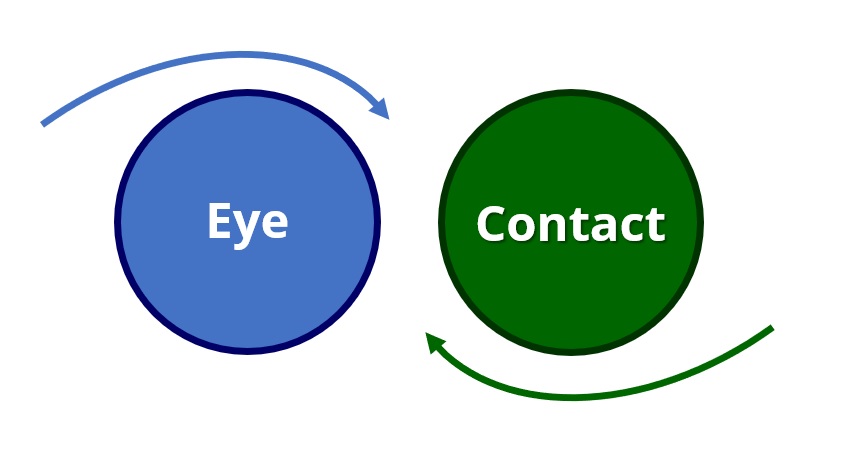This post on Eye Contact is #6 in a longer series of articles based on a presentation I gave to the Public Relations Insitute of Australia on “How To Make Your Audience Listen Better.” The Introduction to the series is here.
Fluid words and dazzling images won’t compensate for a lack of non-verbal communications signals when engaging a group of people or a large audience with your ideas. These nonverbal signals – which I put under a general banner of “technique” in presentation skills – are often more powerful than text and pictures. This is particularly true when you’re trying to convey and reinforce your emotions about the ideas, such as passion, sincerity, interest, trust and commitment. There’s few more powerful ways to engage your audience when demonstrating positive eye contact, a strong voice and natural gestures.
Note: Please see my caveat about cultural sensitivity at the end of this post.
Eye Contact Is Arguably the #1 Non-Verbal Comm SKill
The first way to connect to the audience, eye contact establishes engagement. Initially, it’s often matched with a smile, perhaps a handshake or bow, and afterwards, with a broad open face suggesting neutrality.
As the presentation continues, eye contact helps you …
- Sustain the audience’s interest, which in turn helps you build rapport and potentially a more durable relationship.
- Keep their attention focused.
- Recognize if they understand what you’re saying; more so, whether they agree with you, if that’s relevant.
- Demonstrate your credibility and sincerity, both contributing to your establishment of trust.
Some additional points about eye contact when speaking to small groups:
Look at everyone. You can do it two ways: sweeping (or lighthouse), or zigzag. Sweeping is sequential, a smooth path from one side of the room to the other, like the beacon of a lighthouse. It works nicely in a large auditorium. Zigzag jumps from person to person, and appears more natural to the audience, particularly in smaller groups. Don’t just do one style. Use both, adjusting and changing throughout your presentation.
Gain confidence. In the beginning, you can gain confidence by looking at nodders and acceptors, but don’t continue to do so. Involve everyone by treating all audience members the same, even the ones who appear unenthusiastic.
Don’t assume their emotions. An individual may not be looking at you because they’re shy, or they may be thinking about what you’re saying. Your focus should be delivering the messages to the audience in a relevant and engaging way, not assuming an individual’s behavior or jumping to premature conclusions.
Per person, 4-5 seconds is plenty. When you’re speaking, it’s roughly about half the time it takes to say a sentence.
Blink normally. Rapid blinking suggests nervousness, insincerity, or worse, lying.
Eye contact shows respect. Maintain eye contact when listening to an audience member’s question or comment, particularly at the beginning of their statement. It acknowledges that you are interested, and more important, it shows respect.
The problem creeps in when they speak for longer than you expect. You want to show your undivided attention, but you also don’t want to stare at them. It helps to nod or tip your head from side to side. Or, after a suitable length of time, you might drop your gaze to the floor as if deeply considering what they are saying. Other expects suggest saying something, like “go on,” “yes,” or simply “mmm.” That’s fine as long as you don’t interrupt or distract.
Another tactic: glance quickly at other audience members to see if they’re listening. Sometimes this subconsciously encourages the respondent to look around the room, to help them maintain eye contact with their fellow audience members. When they finish, your eye contact returns immediately to answer the question or respond with additional points.
Keep an eye out for confusion. We’ve all seen a person’s face turn into a giant question mark when they don’t understand something we’ve said: a twist of the eyes, lower brows, a scrunch of the nose or mouth. You won’t want to call it out at that moment. But keep a note of it, in case you can bring it up generally during Q&A by allowing them to bring their confusion out in the open, or less so, to reach out to them privately and sensitively after the presentation.
A last word: The use of eye contact, voice and gestures depends greatly on the culture, status, age and gender of your audience.
The points I’ve outlined here are for people presenting to Western audiences, and are not appropriate skills to use for Arab, Latin, Asian or other Eastern audiences. If you travel for work internationally, adapt and match the style of your presentation skills to your audience, not vice versa. Do research and show the utmost respect for your host’s culture.
Any thoughts, advice or questions you have on effectively using eye contact for presentations?


No comment yet, add your voice below!